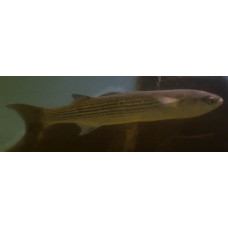Latin name
Chelon auratus
Other names
Chelon auratus
Identification
The body is elongated, low, barely compressed at the sides and covered with large scales. The head is short and flattened. Fat eyelids are poorly developed and only visible on the sides of the eyes. The lateral line is absent, but the scales of the back and upper part of the head show single grooves of the lateral line system. The back and upper half of the head are dark grey, ashy or brownish black with a greenish blue tinge. The lower half of the head, flanks and belly are silvery grey, sometimes almost milky white. The flanks have 6-7 brownish-golden or yellowish-golden stripes between 7-8 silver-black vertical bars. The gill covers have a brownish-yellow or golden spot. Dorsal, pectoral and caudal fins are dark grey, pelvic and anal fins are yellowish-white or greyish-white.
Distribution
Distribution of the species: Eastern Atlantic from the southern coasts of Norway and Sweden to Cape Verde, Mediterranean, Black and Azov Seas, introduced into the Caspian Sea.
Habitat
A marine, gregarious, benthic-pelagic, fast and fearful fish.
Size
Maximum length 59 cm, usually 20-35 cm. Weight up to 1 kg, usually 50-450 g. Life expectancy up to 12 years.
Life history and Behavior
Juveniles and adults make seasonal migrations to coastal waters in spring and summer to feed and breed, and when the water cools to 10°C, they return to the sea to spend the winter. During the feeding season, shoals of this fish, which can be very large, enter shallow waters, bays, lagoons, saline and freshwater estuaries, coastal lakes and occasionally the mouths of rivers, usually in areas with silted, sometimes vegetated bottoms. Juveniles are found mainly in the near-surface layers of water, with large fish found at depths of 1-2 m and deeper. It can withstand strong fluctuations in salinity, the presence of hydrogen sulphide, and high water temperatures up to 29-31°C and even up to 35°C. Fry approach the banks in July-November, juveniles from March-early May to October-November, in some places juveniles stay almost all year round (Crimea) or in winter (Dry estuary).
Food and feeding habits
Juveniles feed on phyto- and zooplankton, supplemented by benthic organisms. Adults feed mainly on micro-benthos and detritus.
Reproduction
Sexual maturity is reached at 3-5 years of age, males at 20-24 cm, females at 26-36 cm. They spawn in July-August in the Black Sea and from mid-August to October in the Caspian Sea. Fecundity is up to 4.4 million eggs. Spawning takes place in the open sea at a considerable distance from the coast. Eggs are pelagic and are laid once or twice.
| Classification | |
| Phylum | Chordata |
| Class | Actinopterygii |
| Squad | Mugiliformes |
| Family | Mugilidae |
| Genus | Chelon |
| Species | C. aurata |
| Features | |
| Conservation status | Least Concern |
| Habitat | Pelagic |
| Life span, years | 12 |
| Maximum body weight, kg | 1 |
| Maximum length, cm | 59 |
| Sailing speed, m/s | No information |
| Threat to people | Edible |
| Way of eating | Not predator |
Golden grey mullet
Tags: golden grey mullet

